‘Virtual Cities’ is the title for a spin-off company which aims to reconstruct Cities in periods of significant architectural and cultural change for visitors, researchers, local history groups and communities to understand the growth, changes and lifestyles of its people over time. Innovation in technology and software has meant that it is significantly easier to achieve scenes of different ages for use in VR and AR using 3D modelling software and the Unreal Game Engine platform. The initial city is Winchester in which Virtual Cities will also implement Heritage Building Information Modelling (HBIM), recording historical information about specific/notable buildings, thereby also creating an additional library of 3D assets for use in research and heritage interpretation.
The HEIF funding will enable Virtual Cities to set up as a spin off company from CEDI, protect the concept, build an identity and create a platform (web application and social media) for accessing the Unreal scenes, stories and information regarding the development of building the city in different eras via different platforms (web, VR, AR, 360 video, story tours and 3D library asset platforms such as Sketchfab).
Imagine a map of Winchester with buildings in all the places where there are stories. We will be creating the buildings, the stories and the means to find them. For stories, think layers. At each place we could tell a bit of a medieval story, a Georgian/Regency story, and perhaps a current story (for example, innovation, arts and crafts/ commercial). The stories can be told using augmented, virtual or mixed reality, by photo, spoken word, original documents, by children, by specialists, all owned, developed, added to and updated by Virtual Cities.
Winchester, as a cultural heritage city, has so much to offer visitors. Much of its built history no longer exists or has changed significantly and therefore may provide a challenge for visitors, especially younger visitors, to understand the scale and importance of the city. There are a number of specific buildings we would recreate which would include historical information such as the people that may have lived/used the building, its built fabric, when built/destroyed/changed and why (please see http://cedi.uk/digital-heritage-design-unit/).
Currently we are reconstructing a portion of Winchester in the Medieval period and Jane Austen’s Georgian period, i.e. 3D Environment (Game & Heritage) and CAD students have already constructed buildings in the Cathedral Close across to College Street, and a section that covers the Great Hall and Westgate under my teaching and supervision. This prototype enables us to test and discover the process and timescales for building the whole city. There will be an example story for each period, relating to specific buildings for users/visitors to engage with on screen and in VR. The medieval and Georgian/Regency prototype will form the initial web application Virtual Cities-Winchester which we will be able to use for proof of concept for further funding.
The expected outcomes from the HEIF funding are:
- Virtual Cities as a spin off company from CEDI/University of Winchester with its own brand identity, web application and social media platforms created.
- The concept protected and the company name and brand device Trade Marked.
- The company structure formed and registered with Companies House.
- A Business Manager employed to set up/start the company.
- An asset library formed for the buildings and other assets created such as the stories, tours and video scenes. The full city scenes would also be a valuable asset for commercialisation such as game based environments, educational/cultural storytelling, television/documentaries and tourism channels.
- A record of the process in creating HBIM buildings and the process for taking buildings into Unreal including creating the land mass, which can then be replicated for future cities/heritage buildings. This record could be developed to a ‘How to’ book for publication with scenes of the Winchester application in progress.
The Virtual Cities company aim is to commercialise the final project/web application via a free subscription (membership) to Virtual Cities-Winchester buildings/streets, with a fee to enter and interact with specific buildings such as 8 College Street (Jane Austen’s Winchester home interior which would be dressed as it may have been when she stayed there), use specific trails, storytelling scenarios and guided tours.
The 3D heritage building assets would be available for a fee/licence for use in other projects (as in a software/music licence), with the completed cities also able to be licenced for use in games, films, documentaries and the metaverse
An initial impact would be for others to access the city for learning more about the city’s changes, cultural and architectural by visually engaging/interacting with the different streets and buildings. This might include local and international tourists, history interest groups and young audiences for education.
Our initial prototype would be used to provide proof of concept to apply for further funding (SMART Innovate/ARHC/Heritage Lottery) to complete the city of Winchester in the two time periods – Medieval and Georgian/Regency.
Some of the buildings created and placed in the Unreal Game Engine:

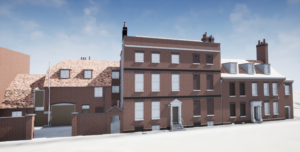
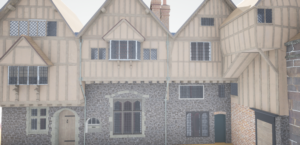
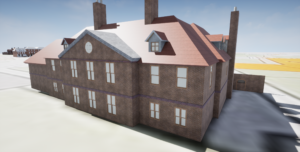
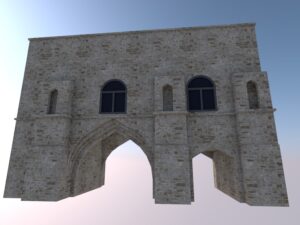
We have been working the prototype for the two eras via the two maps shown below:
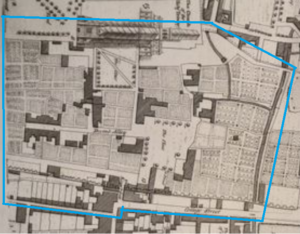
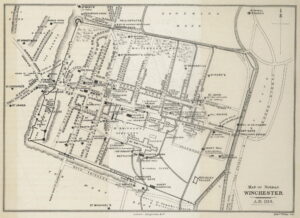
Please contact Dr Debs Wilson for more information.